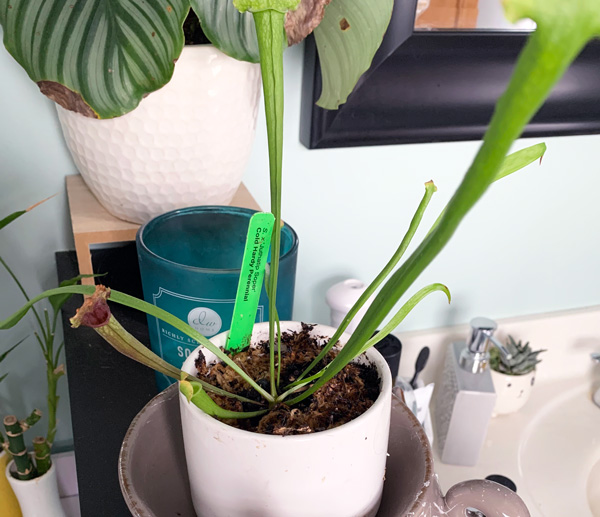January 5, 2023
Q/A #11 - Nepenthes Took a Turn for the Worse
QUESTION:
I had my Nepenthes Gaya, Venus Flytrap, Marston's Dragon sundew, and Sarracenia Juthatip Soper for about a year. I’ve been watering with distilled water. The were thriving in summer in an enclosed sunroom addition. I took them back in to a windowsill when the temps dropped several months ago. I live in the Chicago area.
The Nepenthes took the first turn for the worse. It lost its only pitcher (turned brown) and then the leaves turned. I read the pamphlets again and realized it shouldn’t have been sitting in water for a year. So I gave it a small break for a week to slightly dry out. Then mold seems to have grown on the top. Is it savable or dormant?
The Venus flytrap was doing fine It shriveled into what it is now. Dormant or dead?
My sundew was green and thriving and then it wasn’t anymore. Many shriveled and became brown. Dormant or dead? Eeeek.
(Submitted in January 2022.)

Nepenthes Gaya

Venus Flytrap

Drosera Marston's Dragon

Sarracenia Juthatip Soper
RESPONSE BY JEFF DALLAS:
The Nepenthes Gaya is dead. No hope there. Nepenthes are not bog plants and don't like sitting in water for long periods. It was probably OK during the summer when evaporation and water usage of the plant were high, but now add short days and cool temperatures, and root rot set in and killed it. Lesson learned there; all of us have been there. If you try another Nepenthes in the future, water them like regular houseplants. Get in the habit of feeling the soil. Dry to the touch? Time to water. Always water from the top and let the water drain through. Soil feels moist? Just leave it be.
The Flytrap looks dead. I suspect that the plant died from lack of sun. Judging from the color of the Sarracenia Juthatip Soper and how underdeveloped the leaves are on the sundew, your plants have been in woefully inadequate light. Juthatip Soper should have dark pinkish red leaves. The sundew should be slightly red and upright. They may may pull through if you can change their growing conditions.
Here's the deal. In our growing directions, when we say the plants need full sun, we are not talking "good light". We mean full sun, as in vegetable-garden full sun. Our usual example is that wherever you are thinking of placing a Venus Flytrap, sundew, or Sarracenia, you should be able to grow a tomato plant in that spot. If you couldn't, then it's not bright enough. In our nursery Sarracenia and flytraps get around 10 hours of direct sun during the summer.
Nepenthes can tolerate a bit less light, but indoors, the window should have several hours of direct sun when the sun is out. This means no filters, shading, trees in front of the window, other houses blocking the window, big overhangs, etc. Also the window should face West or South. North windows will never cut it.
For your Sarracenia, it will need to stay indoors until Spring. Chicago is too cold in winter unless you set it up in the Fall to survive winter in your climate. In its current state they would not survive it. Just choose the sunniest window you have, and put it close to the window. The same for your sundew. Even though it's tropical, that particular variety likes LOTS of sunlight. Because of the short cloudy days in winter, you might consider supplementing with artificial light. A small tube or panel type LED grow light can be very helpful. The sundew in particular would benefit from this.
You can keep the Sarracenia and sundew in some water, but avoid more than 1/4 of the way up the pot. It's even ok if the tray goes dry for a day or two. Just be sure the soil doesn't dry out entirely. Your Sarracenia and sundew are not using much water this time of year.
So, focus on light. That is what almost always makes or breaks people in growing these kinds of plants.
•
Submitted in January 2022. The original question and response have been edited for publication.
• With a database of thousands of questions, we will post a Q&A every few days or so.
• To search for similar topics, click on a hashtag below or use the site's search function.
• To submit a carnivorous plant question, visit
Ask the Growers.

